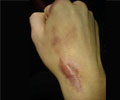Researchers in Israel claim to have perfected a technique called laser welding , in which carbon dioxide lasers are used to seal and heal wounds.
Tel Aviv University researchers in Israel claim to have perfected a technique called "laser welding", in which carbon dioxide lasers are used to seal and heal wounds.
The breakthrough work can reduce may reduce the likelihood of infection and permanent scarring, which are associated with suturing and microsurgery techniques.Prof. Abraham Katzir, a member of the university's Applied Physics Group, says that their work may change the way surgeons bond cuts on the surface of skin and inside the body during surgery.
Some doctors tried using a carbon dioxide laser to seal wounds earlier also, but they lacked the ability to control the heat of the laser, and thus their technique posed even greater risks.
Katzir says that his team has created a device that can heat body tissue in a precisely controlled manner.
He says that with the new device, if the laser begins to overheat and risks burning the tissue, laser power is reduced.
He adds that laser power increases when the temperature is too low to complete a closure.
Advertisement
He has revealed that the unique optical fibres deliver the laser's energy to heat the bonded cut and are used for controlling the temperature.
Advertisement
"Sutures or stitches are not water tight, and blood or urine can pass through cuts, causing severe infection. Also, in many cases, a surgeon needs great skill to perform internal stitching, or in bonding tiny blood vessels, or in mending cuts on the skin so there will be no trace left on the body," he says.
Prof. Katzir says that his team have carried out successful clinical trials on people undergoing gall bladder removal surgery, which suggest that laser-bonded tissues heal faster and have less scarring than sutured cuts.
He says that preliminary findings of the team's work suggest that the novel approach may be used to bond cuts on the cornea, bladder, intestines, blood vessels or trachea.
He also envisions its use for bonding tissues inside the body on organs such as the kidney, and even in brain surgery.
The team say that they will soon be treating longer cuts, such as in the case of hernia operations, with the permission of the Ministry of Health.
They say that their work may lead to a commercial product within a few years if it turns out to be successful in larger tests.
"We think plastic surgeons will especially love this invention. Bonding tissues that heal well without scarring is a true art that few people possess," says Prof. Katzir.
"It could also become a device for the battlefield, allowing soldiers to heal each other on contact with a laser wand," he adds.
Source-ANI
SPH










